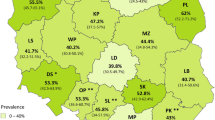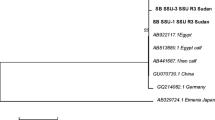Abstract
A total of 1,734 cattle faecal samples from 296 dairy-keeping households were collected from urban settings in Nairobi, Kenya. Modified Ziehl–Neelsen staining method and an immunofluorescence assay were used to identify those samples with Cryptosporidium oocyst infection. Oocysts from positive faecal samples were isolated by Sheather's sucrose flotation method and picked from the concentrate using cover slips. Genomic DNA was extracted from 124 of the faecal samples that were positive for Cryptosporidium and was used as template for nested PCR of the 18S rRNA gene. Twenty-five samples (20 %) were PCR-positive for Cryptosporidium, and 24 of the PCR products were successfully cloned and sequenced. Sequence and phylogenetic analysis identified 17 samples (68 %) as Cryptosporidium parvum-like, four samples (16 %) as Cryptosporidium ryanae, three samples (12 %) as Cryptosporidium andersoni and one sample (4 %) as Cryptosporidium hominis. To the best of our knowledge, this is the first genotyping study to report C. parvum-like, C. andersoni and C. hominis in cattle from Kenya. The results of this study show Cryptosporidium infections in calves and cattle may be potential zoonotic reservoirs of the parasite that infects humans.

Similar content being viewed by others
References
Abreu-Acosta, N., Quispe, M.A., Foronda-Rodríguez, P., Alcoba-Florez, J., Lorenzo-Morales, J., Ortega-Rivas, A. and Valladares, B., 2007. Cryptosporidium in patients with diarrhoea, on Tenerife, Canary Islands, Spain, Annals of Tropical Medicine and Parasitology, 101, 539-545.
Amer, S., Honma, H., Ikarashi, M., Oishi, R., Endo, M., Otawa, K. and Nakai, Y., 2009. The first detection of Cryptosporidium deer-like genotype in cattle in Japan, Parasitology Research, 104, 745-752.
Brook, E., Hart, C.A., French, N.P. and Christley, R.P., 2008. Prevalence and risk factors for Cryptosporidium spp. Infection in young calves, Veterinary Parasitology, 152, 46–52.
Cacciò, S.M. and Pozio, E., 2006. Advances in the epidemiology, diagnosis and treatment of cryptosporidiosis, Expert Review of Anti-Infective.Therapy. 4, 429–443.
Casemore, D.P., Armstrong, M. and Sands, R.L., 1985. Laboratory diagnosis of cryptosporidiosis, Journal of Clinical Pathology, 38, 1337–1341.
Castro-Hermida, J.A., Almeida, A., González-Warleta, M., Correia da Costa, J.M., Rumbo-Lorenzo, C. and Mezo, M., 2007. Occurrence of Cryptosporidium parvum and Giardia duodenalis in healthy adult domestic ruminants, Parasitology Research, 101, 1443-1448.
Fayer, R., Santín, M. and Trout, JM., 2008. Cryptosporidium ryanae n. sp. Apicomplexa: Cryptosporidiidae in cattle Bos taurus, Veterinary Parasitology,156, 191–198.
Fayer, R., Santín, M. and Dargatz, D., 2010. Species of Cryptosporidium detected in weaned cattle on cow-calf operations in the United States, Veterinary Parasitology,170,187-192.
Fayer, R., Santín, M. and Trout, J.M., 2007. Prevalence of Cryptosporidium species and genotypes in mature dairy cattle on farms in eastern United States compared with younger cattle from the same locations, Veterinary Parasitology,145, 260-266.
Fayer, R., Santín, M., Trout, J.M. and Greiner, E., 2006. Prevalence of species and genotypes of Cryptosporidium found in 1-2-year-old dairy cattle in the eastern United States, Veterinary Parasitology, 135, 105-112.
Fayer, R., Santín, M. and Xiao, L., 2005. Cryptosporidium bovis n. sp. Apicomplexa, Cryptosporidiidae in cattle Bos taurus, Journal of Parasitology, 91, 624-629.
Felsenstein J. (1985). Confidence limits on phylogenies: An approach using the bootstrap. Evolution 39:783-791.
Feltus, D.C., Giddings, C.W., Khaitsa, M.L. and McEvoy, J.M., 2008. High prevalence of Cryptosporidium bovis and the deer-like genotype in calves compared to mature cows in beef cow-calf operations, Veterinary Parasitology, 151, 191–195.
Feng, Y., Alderisio, K.A., Yang, W., Blancero, L.A., Kuhne, W.G., Nadareski, C.A., Reid, M. and Xiao, L., 2007. Cryptosporidium genotypes in wildlife from a new york watershed, Applied Environmental Microbiology, 73, 6475-6483.
Gatei, W., Ashford, R.W., Beeching, N.J., Kamwati, S.K., Greensill, J. and Hart, C.A., 2002. Cryptosporidium muris infection in an HIV-infected adult, Kenya, Emerging Infectious Diseases, 8, 204-206.
Gatei, W., Greensill, J., Ashford, R.W., Cuevas, L.E., Parry, C.M., Cunliffe, N.A., Beeching, N.J. and Hart, C.A., 2003. Molecular analysis of the 18S rRNA gene of Cryptosporidium parasites from patients with or without human immunodeficiency virus infections living in Kenya, Malawi, Brazil, the United Kingdom, and Vietnam, Journal of Clinical Microbiology, 41, 1458-1462.
Gatei, W., Wamae, C.N., Mbae, C., Waruru, A., Mulinge, E., Waithera, T., Gatika, S.M., Kamwati, S.K., Revathi, G. and Hart, C.A., 2006. Cryptosporidiosis, prevalence, genotype analysis, and symptoms associated with infections in children in Kenya, American Journal of Tropical Medicine and Hygiene, 75, 78-82.
Gibbons-Matthews, C., Prescott, A.M., 2003. Intra-isolate variation of Cryptosporidium parvum small subunit ribosomal RNA genes from human hosts in England, Parasitology Research, 90, 439-444.
Giles, M., Webster, K.A., Marshall, J.A., Catchpole, J. and Goddard, T.M., 2001. Experimental infection of a lamb with Cryptosporidium parvum genotype 1, Veterinary Record, 149, 523-525.
Halim, N.A., Plutzer, J., Bakheit, M.A. and Karanis, P., 2008. First report of Cryptosporidium deer-like genotype in Malaysian cattle, Veterinary Parasitology, 152, 325–329.
Jenkins, M.W., Tiwari, S., Lorente, M., Gichaba, C.M. and Wuertz, S., 2009. Identifying human and livestock sources of faecal contamination in Kenya with host-specific Bacteroidales assays, Water Research, 43, 4956-4966
Kang'ethe, E.K., McDermott, B., M'Ibui, G.M., Randolph, T.F., Langat, A.K., 2007. Investigation into the prevalence of bovine cryptosporidiosis among small-holder dairy households in Dagoretti Division, Nairobi, Kenya, East African Medical Journal, 8411 Suppl, S76-82.
Kang’ethe, E.K., Randolph, T.F., McDermott, B., Lang’ata, A.K., Kimani, V.N., Kirangu, M., Ekuttan, C., Ojigo, D., Onono, J., Ngonde, A. and Miriti, G., 2005. Characterization of benefits and health risks associated with smallholder dairy production in Dagoretti, Nairobi, Kenya. Final Technical Report submitted to the International Development Research Centre, Canada. IDRC, 102019-004.
Keshavarz, A., Haghighi, A., Athari, A., Kazemi, B., Abadi, A. and Mojarad, E.N., 2009. Prevalence and molecular characterization of bovine Cryptosporidium in Qazvin province, Iran, Veterinary Parasitology, 160, 316-318.
Khan, S.M., Debnath, C., Pramanik, A.K., Xiao, L., Nozaki, T. and Ganguly, S., 2010. Molecular characterization and assessment of zoonotic transmission of Cryptosporidium from dairy cattle in West Bengal, India, Veterinary Parasitology, 171, 41-47
Kváč. M., Hromadová, N., Květoňová, D., Rost, M. and Sak, B., 2011. Molecular characterization of Cryptosporidium spp. in pre-weaned dairy calves in the Czech Republic: absence of C. ryanae and management-associated distribution of C. andersoni, C. bovis and C. parvum subtypes, Veterinary Parasitology, 177, 378-82.
Langkjaer, R.B., Vigre, H., Enemark, H.L. and Maddox-Hyttel, C., 2007. Molecular and phylogenetic characterization of Cryptosporidium and Giardia from pigs and cattle in Denmark. Parasitology 134, 339–350.
Liu, A., Wang, R., Li, Y., Zhang, L., Shu, J., Zhang, W., Feng, Y., Xiao , L. and Ling, H., 2009. Prevalence and distribution of Cryptosporidium spp. in dairy cattle in Heilongjiang Province, China, Parasitology Research. 105, 797-802.
Ma, P. and Soave, R., 1983. Three-step stool examination for cryptosporidiosis in 10 homosexual men with protracted watery diarrhea, Journal of Infectious Disease, 147, 824-828.
Maikai, B.V., Umoh, J.U., Kwaga, J.K., Lawal, I.A., Maikai, V.A., Cama, V. and Xiao, L., 2011. Molecular characterization of Cryptosporidium spp. in native breeds of cattle in Kaduna State, Nigeria, Veterinary Parasitology. 178, 241-245.
Meireles, M.V., Soares, R.M., Bonello, F. and Gennari, S.M., 2007. Natural infection with zoonotic subtype of Cryptosporidium parvum in Capybara Hydrochoerus hydrochaeris from Brazil, Veterinary Parasitology, 147, 166-170.
Muchiri, J.M., Ascolillo, L., Mugambi, M., Mutwiri, T., Ward, H.D., Naumova, E.N., Egorov, A.I., Cohen, S., Else, J.G. and Griffiths, J.K., 2009. Seasonality of Cryptosporidium oocyst detection in surface waters of Meru, Kenya as determined by two isolation methods followed by PCR, Journal of Water and Health, 7, 67-75.
Nei, M. and Kumar, S., 2000, Molecular Evolution and Phylogenetics. Oxford University Press, New York.
Nydam, D.V., Wade, S.E., Schaaf, S.L. and Mohammed, H.O., 2001. Number of Cryptosporidium parvum oocysts or Giardia spp cysts shed by dairy calves after natural infection, American Journal of Veterinary Research, 62, 1612-1615.
Ondrácková, Z., Kvác, M., Sak, B., Kvetonová, D. and Rost, M., 2009. Prevalence and molecular characterization of Cryptosporidium spp. in dairy cattle in South Bohemia, the Czech Republic, Veterinary Parasitology, 165, 141-144.
Paul, S., Chandra, D., Tewari, A.K., Banerjee, P.S., Ray, D.D., Raina, O.K. and Rao, J.R., 2009. Prevalence of Cryptosporidium andersoni, a molecular epidemiological survey among cattle in India, Veterinary Parasitology, 161, 31-35.
Plutzer, J. and Karanis, P., 2007. Genotype and subtype analyses of Cryptosporidium isolates from cattle in Hungary, Veterinary Parasitology, 146, 357–362.
Ryan, U.M., Bath, C., Robertson, I., Read, C., Elliot, A., McInnes, L., Traub, R. and Besier, B., 2005. Sheep may not be an important zoonotic reservoir for Cryptosporidium and Giardia parasites, Applied Environmental Microbiology, 71, 4992-4997.
Ryan, U.M., Samarasinghe, B., Read, C., Buddle, J.R., Robertson, I.D. and Thompson, R.C.A., 2003. Identification of a novel Cryptosporidium genotype in pigs, Applied Environmental Microbiology, 69, 3970–3974.
Saitou, N. and Nei, M., 1987. The neighbour -joining method: Anew method for reconstructing phylogenetic trees. Molecular Biology and Evolution,4, 406-425.
Santı´n, M., Trout, J.M. and Fayer, R., 2008. A longitudinal study of cryptosporidiosis in dairy cattle from birth to two years of age, Veterinary Parasitology,155, 15-23.
Santín, M., Trout, J.M., Xiao, L., Zhou, L., Greiner, E. and Fayer, R., 2004. Prevalence and age-related variation of Cryptosporidium species and genotypes in dairy calves, Veterinary Parasitology, 122, 103–117.
Silverlås, C., Emanuelson, U., de Verdier, K. and Björkman, C., 2009. Prevalence and associated management factors of Cryptosporidium shedding in 50 Swedish dairy herds, Preventive Veterinary Medicine, 90, 242-253.
Siwila, J., Phiri, I.G., Vercruysse, J., Goma, F., Gabriel, S., Claerebout, E., and Geurden, T., 2007. Asymptomatic cryptosporidiosis in Zambian dairy farm workers and their household members, Transactions of the Royal Society for Tropical Medicine and Hygiene, 101, 733–734.
Smith, H.V., Nichols, R.A., Mallon, M., Macleod, A., Tait, A., Reilly, W.J., Browning, L.M., Gray, D., Reid, S.W. and Wastling, J.M., 2005 Natural Cryptosporidium hominis infections in Scottish cattle, Veterinary Record, 156, 710–711.
Soba, B., Petrovec, M., Mioc, V. and Logar, J., 2006. Molecular characterisation of Cryptosporidium isolates from humans in Slovenia, Clinical Microbiology and Infection, 12, 918-921.
Soltane, R., Guyot, K., Dei-Cas, E. and Ayadi, A., 2007. Cryptosporidium parvum Eucoccidiorida, Cryptosporiidae in calves, results of a longitudinal study in a dairy farm in Sfax, Tunisia, Parasitology, 14, 309-312.
Szonyi, B., Kang’ethe, E.K., Mbae, C.K., Kakundi, E.M., Kamwati, S.K. and Mohammed, H.O., 2008. First report of Cryptosporidium deer-like genotype in Kenyan cattle, Veterinary Parasitology, 153, 172–175.
Tamura K., Peterson D., Peterson N., Stecher G., Nei M., and Kumar S., 2011. MEGA5: Molecular Evolutionary Genetics Analysis using Maximum Likelihood, Evolutionary Distance, and Maximum Parsimony Methods. Molecular Biology and Evolution doi:10.1093/molbev/msr121.
Thomaz, A., Meireles, M.V., Soares, R.M., Pena, H.F. and Gennari, S.M., 2007. Molecular identification of Cryptosporidium spp. from faecal samples of felines, canines and bovines in the state of São Paulo, Brazil, Veterinary Parasitology,150, 291-296.
Thompson, H.P., Dooley, J.S., Kenny, J., McCoy, M., Lowery, C.J., Moore, J.E., and Xiao, L., 2007. Genotypes and subtypes of Cryptosporidium spp. in neonatal calves in Northern Ireland, Parasitology Research, 100, 619-624
Thornton, C.G. and Passen, S., 2004. Inhibition of PCR amplification by phytic acid, and treatment of bovine faecal specimens with phytase to reduce inhibition, Journal of Microbiological Methods, 59, 43–52.
Wielinga, P.R., de Vries, A., van der Goot, T.H., Mank, T., Mars, M.H., Kortbeek, L.M. and van der Giessen, J.W., 2008. Molecular epidemiology of Cryptosporidium in humans and cattle in The Netherlands, International Journal of Parasitology, 38, 809-817
Xiao, L. and Ryan, U.M., 2004. Cryptosporidiosis, an update in molecular epidemiology, Current Opinion in Infectious Disease, 17, 483-490.
Acknowledgements
The authors wish to thank the International Research Development Centre for funding this work under the grant 103075-001. We also thank all the members of the research team involved in this project for the support and encouragement in various ways.
We also acknowledge the support given by the BecA-ILRI Hub, for their excellent technical support.
Author information
Authors and Affiliations
Corresponding author
Additional information
This paper is part of a special supplement on assessing and managing urban zoonoses and food-borne disease in two African cities (Nairobi, Kenya and Ibadan, Nigeria).
Rights and permissions
About this article
Cite this article
Kang’ethe, E.K., Mulinge, E.K., Skilton, R.A. et al. Cryptosporidium species detected in calves and cattle in Dagoretti, Nairobi, Kenya. Trop Anim Health Prod 44 (Suppl 1), 25–31 (2012). https://doi.org/10.1007/s11250-012-0202-5
Accepted:
Published:
Issue Date:
DOI: https://doi.org/10.1007/s11250-012-0202-5




